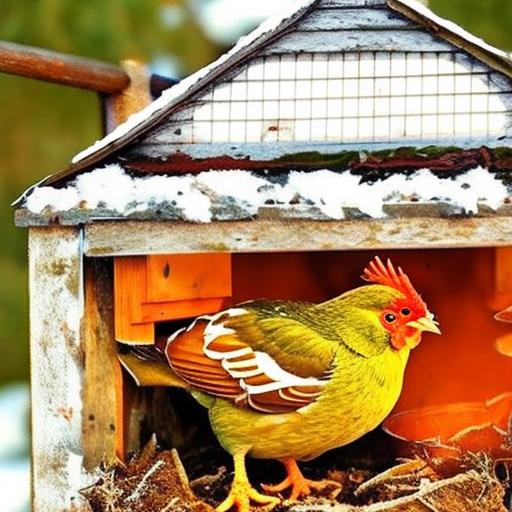Winter can be a challenging time for chickens, as they are naturally adapted to warmer climates. However, with a little preparation and care, you can ensure that your feathered friends stay happy and healthy throughout the winter season. Keeping chickens warm is crucial for their well-being, as extreme cold temperatures can lead to frostbite, respiratory issues, and even death. By understanding the physiology of chickens in cold weather, choosing the right type of coop, insulating the coop, providing proper ventilation, using appropriate bedding, feeding them a nutritious diet, ensuring access to unfrozen water, and using supplemental heat sources when necessary, you can create a cozy and comfortable environment for your chickens during winter.
Key Takeaways
- Keeping chickens warm during winter is important for their health and well-being.
- Understanding the physiology of chickens in cold weather can help you make informed decisions about their care.
- Choosing the right type of coop for winter can make a big difference in keeping your chickens warm.
- Insulating your coop with the right materials and techniques can help retain heat and keep your chickens cozy.
- Balancing ventilation with warmth is crucial for maintaining good air quality and preventing moisture buildup.
Understanding the Physiology of Chickens in Cold Weather
Chickens are naturally equipped to handle cold weather to some extent. They have feathers that provide insulation and help regulate their body temperature. Chickens also have a higher body temperature than humans, typically around 105 degrees Fahrenheit. However, despite these adaptations, they still need some help staying warm during winter.
Chickens have a unique way of regulating their body temperature called thermoregulation. They do this by fluffing up their feathers to create an insulating layer of air between their feathers and skin. This helps to trap heat and keep them warm. Chickens also have a higher metabolic rate in cold weather, which helps generate more body heat.
Understanding how chickens regulate their body temperature can help you create the ideal winter environment for them. Providing them with a well-insulated coop, proper ventilation, and cozy bedding will help them conserve body heat and stay warm during the colder months.
Choosing the Right Type of Coop for Winter
The type of coop you have can make a big difference in how well your chickens stay warm during winter. When choosing a coop for winter, there are several factors to consider.
Firstly, size is important. A coop that is too small can lead to overcrowding, which can make it difficult for chickens to stay warm. Make sure your coop has enough space for your chickens to move around comfortably.
Insulation is another crucial factor. Insulating your coop can help retain heat and keep your chickens warm. There are various insulation materials available, such as foam boards, straw bales, or even recycled denim insulation. Choose a material that is safe for chickens and provides effective insulation.
Ventilation is also important in a winter coop. While it may seem counterintuitive to have ventilation in a cold environment, it is necessary to prevent moisture buildup and ammonia accumulation, which can lead to respiratory issues. Proper ventilation will allow fresh air to circulate while still maintaining a warm environment.
Insulating Your Coop: Materials and Techniques
| Material | Pros | Cons |
|---|---|---|
| Straw | Easy to find and replace, good insulation | Can be messy, attracts pests |
| Hay | Good insulation, readily available | Can be expensive, attracts pests |
| Shavings | Good insulation, easy to clean | Can be expensive, not as readily available |
| Foam board | Excellent insulation, easy to install | Expensive, can be difficult to cut to size |
| Bubble wrap | Good insulation, inexpensive | Not as durable, can be difficult to install |
Insulating your coop is an effective way to keep your chickens warm and comfortable during winter. There are several insulation materials and techniques you can use to achieve this.
One popular insulation material is foam board. Foam boards are easy to install and provide excellent insulation. They can be cut to fit the walls of your coop and attached with adhesive or screws. Foam boards are also resistant to moisture, which is important in preventing mold or mildew growth.
Another option is straw bales. Straw bales can be stacked around the perimeter of the coop to create a barrier against cold air. They provide natural insulation and can be easily removed or replaced when necessary.
Recycled denim insulation is another eco-friendly option for insulating your coop. It is made from recycled denim jeans and provides effective insulation against cold temperatures. It is also safe for chickens and does not contain any harmful chemicals.
In addition to insulation materials, there are also techniques you can use to improve the insulation of your coop. For example, you can add extra layers of bedding on the floor of the coop to provide additional insulation. You can also use draft stoppers or weatherstripping to seal any gaps or cracks in the coop to prevent cold air from entering.
Ventilation: Balancing Fresh Air and Warmth
Good ventilation is crucial for keeping your chickens healthy during winter. While it may seem counterintuitive to have ventilation in a cold environment, it is necessary to prevent moisture buildup and ammonia accumulation, which can lead to respiratory issues.
Proper ventilation will allow fresh air to circulate while still maintaining a warm environment. It is important to strike a balance between fresh air and warmth in your coop. Too much ventilation can result in drafts and make it difficult for chickens to stay warm, while too little ventilation can lead to poor air quality and respiratory issues.
One way to achieve proper ventilation is by using adjustable vents or windows in your coop. These can be opened or closed depending on the weather conditions. You can also use mesh or wire screens on windows or vents to allow fresh air in while keeping predators out.
It is important to regularly check the ventilation in your coop and make adjustments as needed. Monitor the humidity levels and airflow inside the coop to ensure that it is at an optimal level for your chickens’ health and comfort.
Bedding: The Key to Cozy Sleeping Arrangements

Bedding is an important part of keeping your chickens warm and comfortable during winter. It provides insulation, absorbs moisture, and creates a cozy sleeping area for your chickens.
There are several types of bedding you can use in your coop, including straw, wood shavings, pine needles, or shredded paper. Each type of bedding has its own advantages and disadvantages, so it is important to choose one that suits your needs and preferences.
Straw is a popular choice for bedding as it provides good insulation and absorbs moisture well. It also creates a soft and comfortable surface for chickens to sleep on. However, straw can be messy and may need to be replaced more frequently.
Wood shavings are another common bedding option. They are absorbent, easy to clean, and provide good insulation. However, they can be dusty, so it is important to choose low-dust or dust-free varieties.
Pine needles are a natural and aromatic bedding option. They provide good insulation and have antimicrobial properties. However, they can be difficult to find in large quantities.
Shredded paper is a cost-effective bedding option that is readily available. It provides good insulation and absorbs moisture well. However, it may need to be replaced more frequently as it can become compacted over time.
Regardless of the type of bedding you choose, it is important to regularly clean and replace it to maintain a clean and healthy environment for your chickens.
Feeding Your Chickens for Winter Health and Warmth
Proper nutrition is essential for keeping your chickens healthy and warm during winter. Cold temperatures can increase the energy requirements of chickens, so it is important to provide them with a nutritious diet that meets their needs.
During winter, chickens require more calories to maintain their body temperature. You can achieve this by increasing their feed ration or providing them with high-energy treats such as cracked corn or black oil sunflower seeds. These treats are high in fat and provide extra energy for your chickens.
It is also important to ensure that your chickens have access to fresh greens during winter. Fresh greens provide essential vitamins and minerals that may be lacking in their regular feed. You can offer them leafy greens such as kale, spinach, or lettuce, or provide them with sprouted grains or fodder.
In addition to a balanced diet, it is important to ensure that your chickens have access to clean water at all times. Water is just as important as food for your chickens in winter. Dehydration can lead to health issues and decrease their ability to stay warm. To prevent water from freezing, you can use heated waterers or place a heated base under their water container.
Watering Your Chickens: Preventing Freezing and Dehydration
Water is essential for your chickens’ health and well-being, especially during winter. However, cold temperatures can cause water to freeze, making it inaccessible to your chickens. It is important to take steps to prevent freezing and ensure that your chickens have access to unfrozen water at all times.
One option is to use heated waterers. These are specially designed water containers that have a built-in heating element to prevent freezing. Heated waterers are available in various sizes and styles, so you can choose one that suits your needs and the number of chickens you have.
Another option is to use a heated base under your water container. A heated base provides warmth from below, preventing the water from freezing. You can place your regular water container on top of the heated base to keep the water from freezing.
If you do not have access to heated waterers or a heated base, you can use other methods to prevent freezing. For example, you can place a small floating object, such as a ping pong ball or a rubber duck, in the water container. The movement of the object will help prevent the water from freezing.
It is important to regularly check your chickens’ water supply and ensure that it is not frozen. If the water does freeze, replace it with fresh unfrozen water immediately. Dehydration can lead to health issues and decrease your chickens’ ability to stay warm.
Supplemental Heat Sources: When and How to Use Them
In some cases, supplemental heat sources may be necessary to keep your chickens warm during winter. However, it is important to use them safely and effectively to avoid potential hazards.
One common supplemental heat source is a heat lamp. Heat lamps provide warmth and can be hung in the coop to create a warm area for your chickens. However, it is important to use heat lamps with caution. Make sure they are securely attached and positioned away from flammable materials. It is also important to monitor the temperature in the coop and ensure that it does not become too hot.
Another option is a radiant heater. Radiant heaters emit infrared heat, which warms objects directly rather than heating the air. They are a safer option than heat lamps as they do not pose a fire hazard. However, it is still important to use them with caution and follow the manufacturer’s instructions.
When using supplemental heat sources, it is important to gradually acclimate your chickens to the warmer temperatures. Sudden changes in temperature can be stressful for them and may lead to health issues. Start by using the supplemental heat source during the coldest parts of the day and gradually increase the duration as needed.
It is also important to provide your chickens with enough space to move away from the heat source if they become too warm. This will allow them to regulate their body temperature naturally and prevent overheating.
Enjoying Happy, Healthy Chickens All Winter Long
With the right preparation and care, you can keep your chickens happy and healthy all winter long. By understanding the physiology of chickens in cold weather, choosing the right type of coop, insulating the coop, providing proper ventilation, using appropriate bedding, feeding them a nutritious diet, ensuring access to unfrozen water, and using supplemental heat sources when necessary, you can create a cozy and comfortable environment for your feathered friends during winter.
Remember to regularly monitor your chickens’ health and well-being throughout the winter season. Check for signs of frostbite or respiratory issues and make any necessary adjustments to their environment or care routine.
By following these tips and providing your chickens with the care they need, you can enjoy happy and healthy chickens all winter long.
If you’re looking for ways to keep your chickens warm in winter without electricity, you might find this article on large chicken coop ideas from Poultry Wizard helpful. They provide innovative and practical solutions for creating a cozy and insulated space for your feathered friends. Check out their large chicken coop ideas to ensure your chickens stay warm and comfortable during the colder months.
FAQs
What are the best ways to keep chickens warm in winter without electricity?
There are several ways to keep chickens warm in winter without electricity, including insulating the coop, using deep litter, providing warm bedding, and using a chicken sweater or jacket.
How can I insulate my chicken coop?
You can insulate your chicken coop by using materials such as straw bales, foam board insulation, or reflective insulation. You can also use weatherstripping to seal any gaps or cracks in the coop.
What is deep litter?
Deep litter is a method of bedding where layers of straw, wood shavings, or other materials are added to the coop floor throughout the winter. As the layers build up, they create a natural insulation that helps keep the chickens warm.
What kind of bedding should I use?
You can use a variety of bedding materials to keep your chickens warm, including straw, wood shavings, or shredded paper. Make sure to keep the bedding dry and clean to prevent mold and bacteria growth.
What is a chicken sweater or jacket?
A chicken sweater or jacket is a small garment that is designed to keep chickens warm in cold weather. They are typically made of wool or other warm materials and can be purchased or made at home.
Meet Walter, the feathered-friend fanatic of Florida! Nestled in the sunshine state, Walter struts through life with his feathered companions, clucking his way to happiness. With a coop that’s fancier than a five-star hotel, he’s the Don Juan of the chicken world. When he’s not teaching his hens to do the cha-cha, you’ll find him in a heated debate with his prized rooster, Sir Clucks-a-Lot. Walter’s poultry passion is no yolk; he’s the sunny-side-up guy you never knew you needed in your flock of friends!







